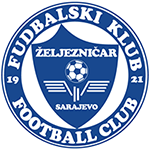Football was played in Sarajevo since the early 20th century, with Sarajevo students and students from different parts of Europe spreading the popularity of this infectious game. Soon after, the first clubs began operating in the city. Although the first club in the city, Osman, was disbanded quickly, it remained recorded as such. Following Osman, other clubs were founded and some had already established a certain reputation by the early twenties, not only in the city but also in wider frameworks.
However, most of the existing clubs were to a lesser or greater extent associated with national structures. Thus, the two leading clubs in the city, SAŠK and Slavija, were unofficial clubs of the Croatian and Serb communities in Sarajevo. Besides them, there were Đerzelez and Barkohba, unofficial clubs of the Bosniak and Jewish communities.
In contrast, there was Hajduk, a club that generally became associated with the working class of the city of Sarajevo and did not have the support of the richer class within the national structures. However, Hajduk itself was insufficient to actively involve an increasing number of football enthusiasts, so the youth of Sarajevo started organizing other teams on an informal basis and playing friendly matches. From today’s perspective, those encounters could be called “raja vs. raja” matches on a big pitch. One such group of guys decided to go a step further. Young workers of the railway workshop in Sarajevo, as well as some of their sons, decided in the autumn of 1920 to establish a real club and agreed on the basic tasks. Given that winter was approaching, and finances were an additional problem, the realization of the idea was eventually postponed to spring. One thing was certain: their lives were in one way or another closely related to the railroad, and the choice of the club’s name was imposed.
It was as if, even then, it could be hinted that the emerging club would face numerous obstacles. Finally, the spring of 1921 arrived, and the young railway workers managed to buy a ball. However, they encountered a problem with the playground. The existing playgrounds belonged to other clubs, and they charged a fee for their use, which the young guys could not afford. Eventually, they decided to use the military training ground at Čengić Vila, the popular Egzercir. The space was adapted to the needs of football, and the first informal activities began. Soon, the first unofficial matches with other similar clubs were arranged, but to take a big step forward and play with the best Sarajevo clubs, registration with the Association was necessary.
In July 1921, an application was submitted for admission of the club to the Sarajevo Sub-Federation. The young and enthusiastic staff easily met the usual administrative requirements. Unfortunately, some individuals seemed to view the emergence of a new workers’ club as a threat, and as a result, additional conditions were abruptly introduced. Nevertheless, the club’s desire was strong enough, and on July 30th, they were rewarded with a statement that read: “Railway Sports Club Sarajevo can be accepted as a member of the Sub-Federation only after playing two matches”. Therefore, only two games remained to be played to prove that the new club is capable of organizing such events without incident.
The first of two conditional matches was played at Skenderija on September 11 against Sarajevo ŠK. Our team did not cope well with the slightly more experienced opponent, resulting in a 5-1 defeat. Six days later, the second game was played against SAŠK, the strongest club in Bosnia and Herzegovina at the time. The match took place at the SAŠK Stadium in Kovačići. To mark the occasion, white T-shirts were purchased in Zagreb, and the first coat of arms on the Željezničar jersey was sewn onto them- a wheel of a locomotive with railway wings. The team included Stefan Cicvol, Milan Tomić, Vilim Novak, Rudolf Kefer, Milovan Adamović, Stjepan Katalinić, Ludvig Leple, Dragutin Siber, Dimitrije Dimitrijević, Ivan Krajnc, and Franjo Cvelfer. In the second half, Ivan Dunkl and Milutin Egić also played. The 1-5 defeat was a realistic reflection of the difference in strength between the two still-unequal teams. However, the result was not the most important thing that day. The players could not have guessed the story they were about to write. With this defeat, the last condition for full membership in the Association was fulfilled. On Monday, September 19, 1921, the Association welcomed the new club into its fold and included it in the second-grade competition calendar for the 1921/1922 season.
Since then, the locomotive has been unstoppable for ten decades..










